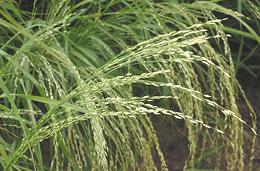Teff
 [Williams Lovegrass, Annual Bunch Grass; Taf (Amharic); Xaafii (Oromo);
Eragrostis tef]
[Williams Lovegrass, Annual Bunch Grass; Taf (Amharic); Xaafii (Oromo);
Eragrostis tef]
This grain is widely grown in Ethiopia and Eritrea, and is used to make the
bread of the region, Injera. It is a
variety of Lovegrass, related to Millet, but with very small grains, averaging
about 0.020 inch wide (0.5 mm) and about 0.039 inches long (1 mm). It takes
about 100 grains to equal the weight of 1 grain of wheat. Despite this small
size, the grains are prolific enough to be worth harvesting. It is grown in
both ivory and brown varieties, with farmers reporting most of their
customers prefer the ivory. The brown is most common in North America, but the
ivory is also grown.
Domesticated Teff has been harvested in Ethiopia for between 3000 and
6000 years, and is now a minor crop in India and Australia. It is
increasingly grown in the western United States as a productive and very
nutritious animal forage crop, alternating with alfalfa in the fields.
This has made it more available for other uses as well. Ethiopia had a
long standing ban on exporting Teff to keep it affordable, but improvement
in agricultural practices allowed that ban to be lifted in 2015.
More on Other Grains.
 In Ethiopia and Eritrea this grain is used to make
Injera, the bread of the
region. It is also the main ingredient in Tella, the beer of the
region, combined with Sorghum and Gesho
(Shiny-Leaf Buckthorn) as an
antimicrobial bitter.
Photo by Rasbak distributed under license Creative Commons
Attribution-Share Alike 3.0 Unported.
In Ethiopia and Eritrea this grain is used to make
Injera, the bread of the
region. It is also the main ingredient in Tella, the beer of the
region, combined with Sorghum and Gesho
(Shiny-Leaf Buckthorn) as an
antimicrobial bitter.
Photo by Rasbak distributed under license Creative Commons
Attribution-Share Alike 3.0 Unported.
Buying:
Teff Seed and Flour are available from a number of
sources for roughly 2021 US $7.95 / pound. Caution: there is another
seed that looks very similar and is often labeled "Teff", but is totally
unrelated - it is seed of London
Rocket, a wild mustard plant, used in beverages in Iran, and now
growing as a widespread invasive here in Southern California.
Health & Nutrition:
This is a very
nutritious grain, and gluten free. It has a high calcium content and
significant amounts of the minerals phosphorus, magnesium, aluminum,
iron, copper, zinc, boron and barium. It is also high in protein,
containing all 8 essential amino acids, and is higher in lysine than
most grains. In addition, it has significant amounts of thiamine and
dietary fiber.
gr_teffz 100313 r 210402 - www.clovegarden.com
©Andrew Grygus - agryg@clovegarden.com - Photos on this
page not otherwise credited are © cg1 -
Linking to and non-commercial use of this page permitted
 In Ethiopia and Eritrea this grain is used to make
Injera, the bread of the
region. It is also the main ingredient in Tella, the beer of the
region, combined with Sorghum and Gesho
(Shiny-Leaf Buckthorn) as an
antimicrobial bitter.
Photo by Rasbak distributed under license Creative Commons
Attribution-Share Alike 3.0 Unported.
In Ethiopia and Eritrea this grain is used to make
Injera, the bread of the
region. It is also the main ingredient in Tella, the beer of the
region, combined with Sorghum and Gesho
(Shiny-Leaf Buckthorn) as an
antimicrobial bitter.
Photo by Rasbak distributed under license Creative Commons
Attribution-Share Alike 3.0 Unported.
 [Williams Lovegrass, Annual Bunch Grass; Taf (Amharic); Xaafii (Oromo);
Eragrostis tef]
[Williams Lovegrass, Annual Bunch Grass; Taf (Amharic); Xaafii (Oromo);
Eragrostis tef]